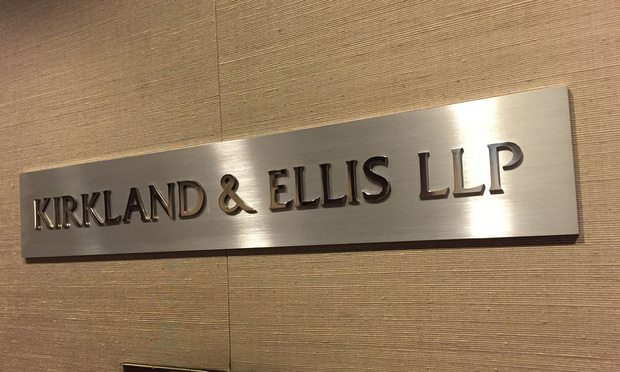Daily Dicta: Playing It Cool: Kirkland Litigators Freeze AC Class Action
You know the old saying, 'If you don't succeed, try, try again'? Sometimes that just means you fail twice.
May 20, 2020 at 01:41 AM
5 minute read

You know the old saying, 'If you don't succeed, try, try again'?
Sometimes that just means you fail twice.
That's what happened when plaintiffs lawyers got a second bite at the apple in a putative class action against heating ventilation and air conditioning systems maker Carrier Corp..
It's a win for a Kirkland & Ellis team led by Winn Allen and Devin Anderson, who slogged through four and a half years of litigation in the Central District of California to defeat—again—a motion for class certification.
 It's not that the plaintiffs' claims were frivolous. They actually strike me as pretty sympathetic. Lawyers from Chimicles Schwartz Kriner & Donaldson-Smith and Shepherd Finkelman Miller & Shah (who did not respond to a request for comment) sued on behalf of people who either installed a new Carrier air conditioner in their house, or who bought a newly-constructed house that came with a new Carrier A/C. But within weeks or months of installation, the brand-new units failed.
It's not that the plaintiffs' claims were frivolous. They actually strike me as pretty sympathetic. Lawyers from Chimicles Schwartz Kriner & Donaldson-Smith and Shepherd Finkelman Miller & Shah (who did not respond to a request for comment) sued on behalf of people who either installed a new Carrier air conditioner in their house, or who bought a newly-constructed house that came with a new Carrier A/C. But within weeks or months of installation, the brand-new units failed.
That's definitely not cool. (Haha get it?)
The problem? The thermal expansion valve—a key component that "controls the expansion of refrigerant central to the cooling process." (There's A LOT more in court papers about thermal expansion valves—or TXV, for those in the know—but I'll spare you the details.)
The alleged culprit is a chemical rust inhibitor called Ryconox that Carrier began adding to the manufacturing process in late 2013.
"The rust inhibitor reacts with the refrigerant and/or oil and causes a tar or sludge to form when the systems are put into service. This sticky substance then circulates through the system, and builds up layers of deposits on the inside of the system," the complaint states.
That tarry gunk allegedly makes the TXV get stuck, rendering the system inoperable or to run less efficiently.
People who shelled out thousands on a new AC were understandably unhappy.
Nor was it an easy fix. According to the plaintiffs, Carrier in 2014 offered to replace the TXVs and provide a $400 credit for labor. But the plaintiffs said that wasn't actually enough to cover the cost of the work, and it didn't solve the problem.
"[S]imply replacing the gunked-up TXVs did not, and could not, clear the contaminants fully from the affected HVAC systems. Thus, the systems continued to fail, and even those that did not experience an immediate failure are at risk of future failure because the contaminants remain in the HVAC system," they claimed.
So Carrier changed course, instructing service personnel to inject another chemical, called A/C Re-New, to break up the sludge. The company provided the chemical for free and gave a $195 service credit.
"However, this course of action manifestly fails to remedy the defect—i.e., remove the contamination—and creates a whole host of other problems," according to the plaintiffs. They say the chemical "merely adds more contamination, none of which should be in a brand-new air conditioning system. The chemical tar continues to circulate through the HVAC system, posing a likelihood of future re-occurrence."
The plaintiffs say the answer is to flush out the systems to remove the impurities, and then replace the filters and the TXV. But they say Carrier opted instead for a cheap repair that "will merely forestall problems to a future date, at which time defendants hope the systems will no longer be under warranty."
In many ways, this case strikes me as well-suited for a class action, with a large group of readily identifiable people facing a common problem. Moreover, the amount of money at issue isn't trivial (i.e. it's not one of those 'You're-entitled-to-$6.30-for-buying-Charmin-wipes' type cases), nor is it so large to make it worthwhile to go it alone.
In 2019, U.S. District Judge Christina Snyder denied a prior motion for class certification, but did so without prejudice, allowing plaintiffs another chance to prove they could satisfy the requirements for class treatment. Plaintiffs retained a new expert, engaged in new discovery and tried again.
This time around, their motion cleared the requirements for numerosity, commonality and adequacy. But Snyder found it fell short on predominance.
The plaintiffs argued all HVAC units containing Ryconox are defective, but the judge noted that many members of the proposed class have continued to use their units, unaware of any problems.
Also, the failure rates for different sized units are different, she continued, "meaning that a duty to disclose, pursuant to California law, may exist to some, but not all, of the proposed class members."
The judge also noted that the plaintiffs' expert "offered no method to determine which class members' HVAC systems will suffer acute failure. Thus, individualized inquiries would be necessary to determine whether a duty to disclose exists."
The Kirkland team also undermined a survey by another plaintiffs' expert that attempted to establish materiality or causation—that is, would consumers have behaved differently if they knew about the Ryconox issue prior to purchase? Snyder was persuaded that the survey was insufficient in querying "how consumers 'valued' Carrier's alleged omissions 'compared to other attributes of the product and the relevant market generally."
Should the plaintiffs appeal her decision to the Ninth Circuit, at least one judge will be recused—Dan Bress, who worked on the case as a Kirkland partner before ascending to the bench in July of 2019.
This content has been archived. It is available through our partners, LexisNexis® and Bloomberg Law.
To view this content, please continue to their sites.
Not a Lexis Subscriber?
Subscribe Now
Not a Bloomberg Law Subscriber?
Subscribe Now
NOT FOR REPRINT
© 2025 ALM Global, LLC, All Rights Reserved. Request academic re-use from www.copyright.com. All other uses, submit a request to [email protected]. For more information visit Asset & Logo Licensing.
You Might Like
View All

What a Boost in Infrastructure and Manufacturing Spending in the U.S. Means for Construction Litigators

Litigators of the Week: In Largest MDL to Date, 3M Settles for $6B With Veterans Claiming Hearing Damage

Litigators of the Week: Quinn Emanuel Slashes $137M Racial Discrimination Verdict Against Tesla by Nearly 98%
Law Firms Mentioned
Trending Stories
- 1SDNY Criminal Division Deputy Chief Returns to Debevoise
- 2Brownstein Adds Former Interior Secretary, Offering 'Strategic Counsel' During New Trump Term
- 3Tragedy on I-95: Florida Lawsuit Against Horizon Freight System Could Set New Precedent in Crash Cases
- 4Weil, Loading Up on More Regulatory Talent, Adds SEC Asset Management Co-Chief
- 5Big Banks Did Great Last Year. What Does That Mean for Big Law?
Who Got The Work
J. Brugh Lower of Gibbons has entered an appearance for industrial equipment supplier Devco Corporation in a pending trademark infringement lawsuit. The suit, accusing the defendant of selling knock-off Graco products, was filed Dec. 18 in New Jersey District Court by Rivkin Radler on behalf of Graco Inc. and Graco Minnesota. The case, assigned to U.S. District Judge Zahid N. Quraishi, is 3:24-cv-11294, Graco Inc. et al v. Devco Corporation.
Who Got The Work
Rebecca Maller-Stein and Kent A. Yalowitz of Arnold & Porter Kaye Scholer have entered their appearances for Hanaco Venture Capital and its executives, Lior Prosor and David Frankel, in a pending securities lawsuit. The action, filed on Dec. 24 in New York Southern District Court by Zell, Aron & Co. on behalf of Goldeneye Advisors, accuses the defendants of negligently and fraudulently managing the plaintiff's $1 million investment. The case, assigned to U.S. District Judge Vernon S. Broderick, is 1:24-cv-09918, Goldeneye Advisors, LLC v. Hanaco Venture Capital, Ltd. et al.
Who Got The Work
Attorneys from A&O Shearman has stepped in as defense counsel for Toronto-Dominion Bank and other defendants in a pending securities class action. The suit, filed Dec. 11 in New York Southern District Court by Bleichmar Fonti & Auld, accuses the defendants of concealing the bank's 'pervasive' deficiencies in regards to its compliance with the Bank Secrecy Act and the quality of its anti-money laundering controls. The case, assigned to U.S. District Judge Arun Subramanian, is 1:24-cv-09445, Gonzalez v. The Toronto-Dominion Bank et al.
Who Got The Work
Crown Castle International, a Pennsylvania company providing shared communications infrastructure, has turned to Luke D. Wolf of Gordon Rees Scully Mansukhani to fend off a pending breach-of-contract lawsuit. The court action, filed Nov. 25 in Michigan Eastern District Court by Hooper Hathaway PC on behalf of The Town Residences LLC, accuses Crown Castle of failing to transfer approximately $30,000 in utility payments from T-Mobile in breach of a roof-top lease and assignment agreement. The case, assigned to U.S. District Judge Susan K. Declercq, is 2:24-cv-13131, The Town Residences LLC v. T-Mobile US, Inc. et al.
Who Got The Work
Wilfred P. Coronato and Daniel M. Schwartz of McCarter & English have stepped in as defense counsel to Electrolux Home Products Inc. in a pending product liability lawsuit. The court action, filed Nov. 26 in New York Eastern District Court by Poulos Lopiccolo PC and Nagel Rice LLP on behalf of David Stern, alleges that the defendant's refrigerators’ drawers and shelving repeatedly break and fall apart within months after purchase. The case, assigned to U.S. District Judge Joan M. Azrack, is 2:24-cv-08204, Stern v. Electrolux Home Products, Inc.
Featured Firms
Law Offices of Gary Martin Hays & Associates, P.C.
(470) 294-1674
Law Offices of Mark E. Salomone
(857) 444-6468
Smith & Hassler
(713) 739-1250






